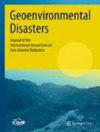Consequences of slope instability and existing practices of mitigation in hydropower projects of Nepal
IF 4
Q2 ENVIRONMENTAL SCIENCES
引用次数: 0
Abstract
Nepal has witnessed several instances of slope instability associated with Hydroelectric Projects in the recent decades. Despite this, slope instability tends to receive less attention compared to other hazards. The objective of this study is to investigate fourteen hydroelectric projects with the aim of identifying the types and causes of slope failures. Additionally, it seeks to offer a comprehensive understanding of slope stability conditions and challenges encountered during construction at project sites. To accomplish this, the study employs Key Informant Interviews with Questionnaires to delve into the slope stability concerns within Nepal’s hydropower projects. The findings are then validated through an extensive review of pertinent literature. To conduct a thorough assessment of slope stability, the study relies on on-site observations, measurements, investigations, and both in-situ and laboratory tests. It becomes evident that the careful selection of study sites, the application of geotechnical methods, and the establishment of regular monitoring are pivotal for ensuring favorable slope stability outcomes. A majority of respondents concur that cutslope is the primary factor causing slope instability with 44.4% answering affirmatively. An independent t-test reveals there is no significant difference between the variables. Moreover, the correlation which is closed to 1 suggests that perception of respondents are interconnected and tend to vary in a synchronized manner. Participants in the study widely acknowledge numerical modeling methods as a means to overcome the limitations of slope stability studies.尼泊尔水电工程边坡不稳定的后果和现有的缓解措施
近几十年来,尼泊尔发生了多起与水电项目相关的斜坡失稳事件。尽管如此,与其他灾害相比,斜坡失稳往往很少受到关注。本研究旨在调查 14 个水电项目,以确定斜坡崩塌的类型和原因。此外,本研究还力求全面了解斜坡稳定性条件以及项目现场施工过程中遇到的挑战。为了实现这一目标,本研究采用了关键知情人访谈和问卷调查的方式,深入研究尼泊尔水电项目中的边坡稳定性问题。然后,通过广泛查阅相关文献,对研究结果进行验证。为了对边坡稳定性进行全面评估,研究依赖于现场观察、测量、调查以及现场和实验室测试。显而易见,谨慎选择研究地点、应用岩土工程方法以及建立定期监测机制对于确保取得有利的斜坡稳定性结果至关重要。大多数受访者都认为切坡是造成边坡不稳定的主要因素,44.4%的受访者给出了肯定的答案。独立 t 检验表明,变量之间没有显著差异。此外,接近 1 的相关性表明,受访者的看法是相互关联的,并趋于同步变化。研究参与者普遍认为数值模拟方法是克服斜坡稳定性研究局限性的一种手段。
本文章由计算机程序翻译,如有差异,请以英文原文为准。
求助全文
约1分钟内获得全文
求助全文
来源期刊

Geoenvironmental Disasters
Social Sciences-Geography, Planning and Development
CiteScore
8.90
自引率
6.20%
发文量
22
期刊介绍:
Geoenvironmental Disasters is an international journal with a focus on multi-disciplinary applied and fundamental research and the effects and impacts on infrastructure, society and the environment of geoenvironmental disasters triggered by various types of geo-hazards (e.g. earthquakes, volcanic activity, landslides, tsunamis, intensive erosion and hydro-meteorological events).
The integrated study of Geoenvironmental Disasters is an emerging and composite field of research interfacing with areas traditionally within civil engineering, earth sciences, atmospheric sciences and the life sciences. It centers on the interactions within and between the Earth''s ground, air and water environments, all of which are affected by climate, geological, morphological and anthropological processes; and biological and ecological cycles. Disasters are dynamic forces which can change the Earth pervasively, rapidly, or abruptly, and which can generate lasting effects on the natural and built environments.
The journal publishes research papers, case studies and quick reports of recent geoenvironmental disasters, review papers and technical reports of various geoenvironmental disaster-related case studies. The focus on case studies and quick reports of recent geoenvironmental disasters helps to advance the practical understanding of geoenvironmental disasters and to inform future research priorities; they are a major component of the journal. The journal aims for the rapid publication of research papers at a high scientific level. The journal welcomes proposals for special issues reflecting the trends in geoenvironmental disaster reduction and monothematic issues. Researchers and practitioners are encouraged to submit original, unpublished contributions.
 求助内容:
求助内容: 应助结果提醒方式:
应助结果提醒方式:


